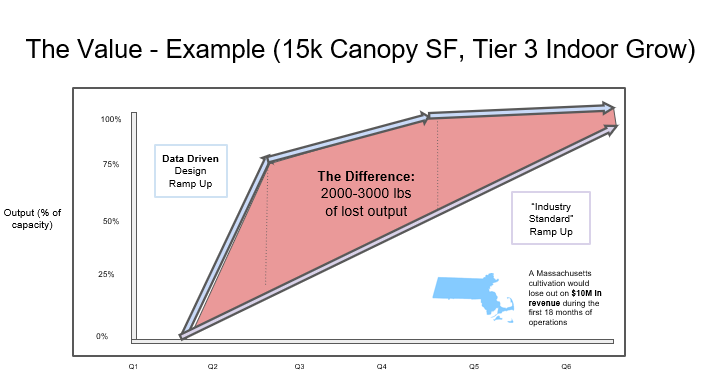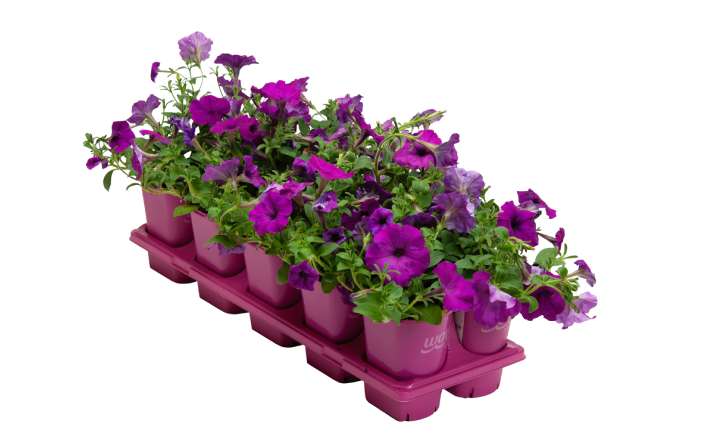Avoiding Cannabis Crop Loss in Cultivation
The impacts of crop loss for cannabis businesses are especially painful due to the high market value of the crop. Due to such high-potential value risk, it is crucial that cultivators take a careful and close look at their operating systems, facility design, and best practices for their environment.
Resource Innovation Institute is a non-profit organization committed to cultivating a better future for all of humanity. Our consortium of members brings perspectives from across the field — uniting architects and engineers, growers and operators, researchers and analysts. Together, we measure, verify and celebrate the world’s most efficient agricultural ideas. In this article, RII’s Technical Director and members of the organization’s Technical Advisory Council working groups share perspectives on the root causes of crop loss and best practices for avoiding crop degradation.
Crop Loss Is Profit Loss
In cannabis, crop loss occurs primarily when growers cannot or do not control the environment to satisfy the needs of a sensitive crop. Environmental issues can kick off any number of pest and pathogen issues, which can further degrade crop quality and lead to complete crop loss.
Crop degradation can manifest in many ways. Losing days of biomass production due to suboptimal greenhouse conditions means plants are not hitting their full potential.
Crop loss can describe changes in productivity growers see in final yields or in expected productivity rates.
Cannabis growers monitor crop quality very closely. Starting up facilities can take more than a year, and getting to the first harvest is critical for businesses to recoup investments. Innovative growers ensure systems can maintain the environmental conditions necessary for their plants to achieve optimal crop quality to maximize profits faster.
As organizations design facilities and seek to continuously increase profits, it is recommended to conduct an overarching analysis of the existing hierarchical structure of that organization’s people, processes, and systems. As we are discussing in this article, overall crop loss or crop degradation can typically be traced back to a deficiency in one of these three areas.
Business leaders must ask themselves:
- Do we have the right people?
- Do we have the right processes in place?
- Do we have the right systems?
If any one of these three suffers a critical error, there is the potential for a whole crop cycle to be lost – be it one table, one room, or a whole greenhouse worth of product.
Root Causes of Crop Loss
Monitor greenhouse operations for the major contributors to crop degradation:
- Check your system capacity and capabilities.
Many operations grow cannabis in greenhouses that used to grow other crops or used different cultivation approaches. This means that systems may not be sized appropriately for environmental control of the new configuration with a new crop.
This can cause crop degradation and loss because productivity rates may decrease when target environmental conditions are not maintained because equipment is inadequate to meet growers’ desired targets.
When retrofitting greenhouses, engage with a professional greenhouse design team that has experience in controlled environment greenhouses with expertise relevant to your region and climate. - Understand when your system was last commissioned.
Cannabis operations focused on ramping up production may start growing before functionally testing mission-critical greenhouse systems. Even if systems were properly designed, equipment may not be operating at its full potential. Commissioning activities validate that systems in facilities run according to specifications and efficiently, which can reduce operating and maintenance costs.
When commissioning greenhouse environmental controls and building envelope systems, check system design against actual performance. Test the ability of your environmental control systems to meet your targets and maintain them continuously. Identify ways to maximize and/or increase production by using equipment more efficiently and also plan capital investments.
Train operators to ensure facility staff understand how the different modes of cooling and ventilation are staged to achieve environmental control targets. Greenhouses have many different modes of environmental control systems, like energy screens, shade cloths, vents, fans, and cooling and heating systems. Cannabis greenhouses may use specialized equipment to manage both temperature and humidity. Some systems may need to be used differently depending on facility location and infrastructure. - Observe trends in equipment performance.
Greenhouse system performance can deteriorate over time, resulting in degraded crop quality and productivity. Marginal or outright equipment failures lead to poor maintenance of environmental conditions, leading to output loss or pest / pathogen issues. During design, determine a robust narrative for how backup equipment should be staged to react when primary equipment goes down.
Data from sensors can detect marginal performance or failing environmental control equipment before it manifests in your plants. Some data from sensors can support other business goals, such as testing and reporting for compliance with regulations. - Set and adhere to standard operational best practices for environmental control.
Support your staff with clear processes that seek to prevent crop degradation. Some examples include:
- Protocols for biological control like disinfecting tables after harvest
- Protocols for personnel such as decontaminating before walking in or out of cultivation spaces, closing doors to prevent influx of pests and pathogens
- Protocols for hygiene to achieve clean rooms with clean floors and clean hands
- Protocols for adherence to schedules, such as processes to be completed at certain times or frequencies.
Maintaining Productivity
How your operation measures productivity, sets targets, and tracks against goals can inform action steps to avoid complete crop loss. Determine your target productivity and understand what is an acceptable deviation from that target. Some commercial cannabis growers find crop degradation from poor growing conditions to result in lost output of 0.5 to 1 gram per square foot per day (varies depending on facility setup).
Lost output translates to lost revenue. The graph below shows the startup period of a Massachusetts cannabis cultivation facility with 15,000 square feet of flowering canopy. If a data-driven approach is used to track trends and adhere to best practices, the business could produce 2,000 to 3,000 pounds more than an industry standard ramp-up approach. If operations do not monitor system performance and use models to assure investors production will get there eventually, the business could lose out on $10 million in revenue in the first 18 months of operation.

Image: Michael Zartarian
When productivity rates go down, your team has to use more labor hours to accomplish the same, or lower yields. Bottom lines for cannabis production are based on the time your People spend with plants. Optimize your systems and processes to support streamlined operations:
- Regular maintenance of systems and equipment will help ensure your facility is running smoothly
- Regular continuous improvement initiatives to processes will ensure that you are not only course correcting where possible, but also that your processes remain relevant and up to date over time
- Regular review of performance metrics for the company’s employees and periodic check-ins with the teams can give leadership peace-of-mind that their operations are running smoothly and the risk management for crop loss and degradation is mitigated.
Tuning Systems
Treat greenhouses as operational systems. During startup, make predictions, collect data, and create feedback loops. Part of the horticultural commissioning process is tuning the entire system during the startup operations phase. As the facility is filled with plants, pay constant attention to the plant environment and environmental control systems as they begin to put through their paces with real plants. It pays dividends to make adjustments long before the crop is affected.
For example, check fan settings at different times in the crop cycle. In many greenhouse operations, the size and shape of the canopy are quite dynamic. This leads to different airflow patterns at different crop heights. Instead of eventually letting the plants in one area be deficient, measure airflow, trend and monitor data, and correct microclimates with distributed climate sensors during the first few cycles of operations.
Proving Performance with Data
To effectively minimize crop degradation and avoid crop loss, create benchmarks with historic data. Isolate periods of effective system performance to paint a picture of a healthy facility for later troubleshooting. If the system is working well, this data can be used to help look for patterns and problems encountered later. Consider tracking benchmarks with RII’s Cannabis PowerScore resource benchmarking platform to get free and confidential competitive performance rankings of your facility key performance indicators (KPIs) for energy, water and emissions, including solid waste and CO2e (measuring carbon associated with energy use).
One KPI measured by PowerScore includes energy efficiency: energy use per unit of canopy area (for example, kBtu per square foot of flowering canopy). If data shows that energy-consuming systems are using more electricity than you think they should, consult historic benchmarks. Looking back at a batch of effective performance data, you can compare current energy consumption to that of your benchmark dataset, narrowed to a period in the past with similar environmental and operational conditions.
Analyze data to support intended production goals using the data your team can capture effectively. Tie yield data to resource usage or quality characteristics to determine the consequences of changes in productivity rates. For example, yield may have increased, but often inputs may have increased as well. The PowerScore KPI for resource productivity measures units of biomass produced per unit of resource (for example, grams of dry cannabis flower per gallon of energy). Understand the inputs needed to achieve final outputs. Inputs like electricity, gas, water, and nutrients need to be analyzed in balance with the wider business needs of the farm. Benchmarking makes it possible to parse out the cause and effect in a complex agriculture system.
In a market that is continually evolving yet also becoming more saturated, It has become more imperative to maximize our production through optimizations of all the farm systems. The farm systems include everything from the plants, to the environment, to the people and processes developed. Without understanding how much an input contributes to a specific output, the farm system is not operating optimally.
Keep an eye out for additional tips in Resource Innovation Institute’s next peer-reviewed Best Practices Guide on Automation & Controls for Cannabis Producers coming soon. Consider benchmarking your greenhouse operation with PowerScore. Dig deeper by joining RII and participating in our Technical Advisory Council working groups.










